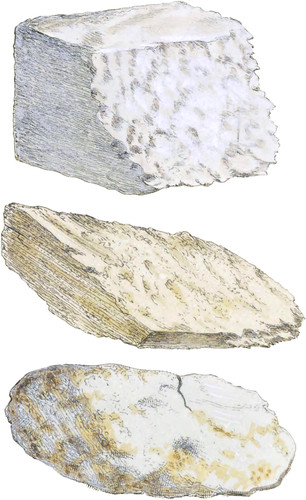 Enlarge
Enlarge
British Mineralogy
Common Clay
- Class 2. Earths.
- Order 2. Mixed.
- Gen. 4. Pulverulent Quartz.
- Spec. 1. Mixed with Argilla.
- Syn.
- Potters Clay. Kirw. 1. 180.
- Clay. Bab. 50.
- Argile glaise. Haüy, 4. 442.
- Loam, Potters Clay, Pipe Clay, and Variegated Clay. Jameson, 1. 301.
The best Pipe Clay (upper figure) is from Teignmouth in Devonshire, and is used in large quantities (being washed, and made plastic with water) for forming tobacco-pipes, and mixing in various sorts of pottery, at Vauxhall, &c. Much the same substance is found at Cambridge, called Gault, and is used for similar purposes, and of the more sandy sort are made whitish tiles and bricks. These nearly resemble the Flanders and Bath bricks*, as they are called; now I suppose a great and profitable article of trade, as they sell at a good price, 4d. each, for cleaning knives, &c.
Pool, in Dorsetshire—see middle figure—has much of this Clay, but rather inferior in quality in general.
Alum Bay in the Isle of Wight and Holyhead in Wales—sec lower figure—afford Clays of this kind, besides many other parts of Great Britain.
Clay in common is best characterized when wet and soft, in which state it is most generally found below the common surface of the Earth. It is known by its plastic qualities, and fitness to be formed into any shape. Thus specimens of common Clay are scarcely to be described by their fracture, and, being generally gathered in a moist state, have the marks of the tool, and are frequently made into balls or squares. Their tenacity, however, gives them a raggedness in breaking, rather peculiar to themselves, smoothest on the sides, and somewhat roughish or earthy; but when dry it varies much, according to circumstances, and is sometimes a little conchoidal. It is chosen as white as possible for pipe-making, and for the finer purposes, and certain proportions of different kinds are used to suit the intention of the potter. For making tobacco-pipes it is burnt or baked so as to stick to the tongue or lips, but is sometimes polished. In making china it is generally more baked and smoother, which adds to its hardness. This is said to be the best Clay for glass-house melting-pots. It is often used in the composition of artificial stone, and for cleaning cloth, wool and leather.
Pure Clay is said to have been found at Halle, in Saxony, but some doubts have arisen as to its being natural. This, according to Fourcroy, is composed of
| Alumine | 45 |
| Sulphate of Lime | 24 |
| Water | 27 |
| Silica and a Muriate | 4 |
| 100 |
- * Which only differ in containing a much greater quantity of Sand.

